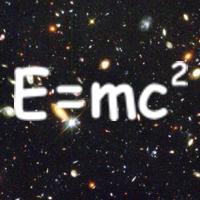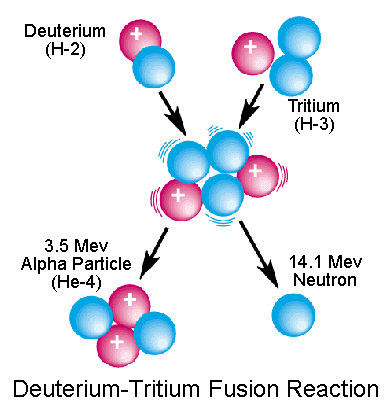http://www.associatedcontent.com/article/11076/fusion_energy_bringing_the_power_of.html
http://en.wikipedia.org/wiki/Nuclear_fusion
http://www.jet.efda.org/pages/content/fusion1.html
http://en.wikipedia.org/wiki/Timeline_of_nuclear_fusion
http://www.atomicarchive.com/Fusion/Fusion1.shtml
http://www.upei.ca/~physics/p261/projects/fusion1/howfusionrxnswork.htm
Tuesday, November 28, 2006
Monday, November 27, 2006
Advantages of Fusion
There are many advantages that come from nuclear fusion. If fusion is controlled the power coming from this reaction  will/can increase the availability of energy by alot. The reactants required for fusion power are also easily accessible. Deuterium (form of hydrogen) is found in sea water and Tritium (another form of hydrogen) can be taken out from lithium. Fusion also produces way less radioactive byproducts, and doesn't contribute to water or air pollution. There are no dangers of a meltdown and no catastrophic events can occur from fusion reactors. Once scientists and engineers figure out how to control fusion better, it will be able to take over fission for most of the reasons described above.
will/can increase the availability of energy by alot. The reactants required for fusion power are also easily accessible. Deuterium (form of hydrogen) is found in sea water and Tritium (another form of hydrogen) can be taken out from lithium. Fusion also produces way less radioactive byproducts, and doesn't contribute to water or air pollution. There are no dangers of a meltdown and no catastrophic events can occur from fusion reactors. Once scientists and engineers figure out how to control fusion better, it will be able to take over fission for most of the reasons described above.
 will/can increase the availability of energy by alot. The reactants required for fusion power are also easily accessible. Deuterium (form of hydrogen) is found in sea water and Tritium (another form of hydrogen) can be taken out from lithium. Fusion also produces way less radioactive byproducts, and doesn't contribute to water or air pollution. There are no dangers of a meltdown and no catastrophic events can occur from fusion reactors. Once scientists and engineers figure out how to control fusion better, it will be able to take over fission for most of the reasons described above.
will/can increase the availability of energy by alot. The reactants required for fusion power are also easily accessible. Deuterium (form of hydrogen) is found in sea water and Tritium (another form of hydrogen) can be taken out from lithium. Fusion also produces way less radioactive byproducts, and doesn't contribute to water or air pollution. There are no dangers of a meltdown and no catastrophic events can occur from fusion reactors. Once scientists and engineers figure out how to control fusion better, it will be able to take over fission for most of the reasons described above.
Plans For The Future
In the future one of the major projects that scientists and engineers will be working on is the International Thermonuclear Experimental Reactor (ITER). The approximate cost to build and operate this reactor is 10 billion euros (14.8 billion dollars CAD). Its scheduled to start operating in 2015. By the mid 21st Century technologies developed from ITER will hopefully be enough to be able to generate electricity from commercial fusion plants. In the future the majority of the world's energy needs might be solved by nuclear fusion.
Nuclear Fusion Today
 In 2005 the host site for related materials research facility was made in Japan. All around the world experiments related to nuclear fusion are still being tested. Right now the largest research facility for nuclear fusion is JET, also known as Joint European Torus. JET was established in 1978 and started operating in 1983. Currently more studies on fusion energy and future electricity-producing fusion power plants are being experimented with. Scientists see many advantages from nuclear fusion that will contribute majorlly in the future.
In 2005 the host site for related materials research facility was made in Japan. All around the world experiments related to nuclear fusion are still being tested. Right now the largest research facility for nuclear fusion is JET, also known as Joint European Torus. JET was established in 1978 and started operating in 1983. Currently more studies on fusion energy and future electricity-producing fusion power plants are being experimented with. Scientists see many advantages from nuclear fusion that will contribute majorlly in the future.Sunday, November 26, 2006
Requirements For Fusion
Before fusion can occur an energy barrier has to be overcome. This energy barrier is created by the repulsive electrostatic force between the protons. At large distances the nuclei repel eachother because of the like charges from the positively charged protons in each of the nuclei. However, nuclear fusion is possible because of the strong nuclear force, which at close distances is stronger than the electrostatic force.

Also because of the repulsion from the protons high temperature and pressure have to be applied. Fusion reactors have to be about 100 degrees Kelvin. Hydrogen turns to a plasma (hot, electrically charged gas) at that high of a temperature. By using microwaves, lazers, and ion particles, high temperatures are achieved. Inorder for atoms to fuse together they need to be extremely close and magnetic feilds, lasers, or ion beams are used to apply large amounts of pressure. The controlling of such high temperature, pressure, and plasma have created science and engineer challenges.
History of Nuclear Fusion
 In 1929 Robert Atkinson and Fritz Houterman developed the theory of nuclear fusion. By using Einstien's discovery that E=MC² they measured the masses of two light elements and concluded that huge amounts of energy could be made by nuclear fusion. Then in 1939 the quantitative theory was developed by Hans Berthe. This theory explained nuclear fusion and contributed majorlly to the theory of nuclear reactions which is why he was awarded the Nobel Prize in Physics in 1967. Later on in the 1950's in the U.S. attempts to achieve controlled nuclear fusion were experimented by building a series of reactors. These experiments also took place in the Soviet Union, Britain, Europe, and Japan. By the 1990's several megawatts of energy were generated for a few minutes because of advanced technology.
In 1929 Robert Atkinson and Fritz Houterman developed the theory of nuclear fusion. By using Einstien's discovery that E=MC² they measured the masses of two light elements and concluded that huge amounts of energy could be made by nuclear fusion. Then in 1939 the quantitative theory was developed by Hans Berthe. This theory explained nuclear fusion and contributed majorlly to the theory of nuclear reactions which is why he was awarded the Nobel Prize in Physics in 1967. Later on in the 1950's in the U.S. attempts to achieve controlled nuclear fusion were experimented by building a series of reactors. These experiments also took place in the Soviet Union, Britain, Europe, and Japan. By the 1990's several megawatts of energy were generated for a few minutes because of advanced technology.Timeline:
1929 - Houterman and Atkinson create the theory of nuclear fusion by using Einstien's E=MC²
1932 - Oliphant discovers helium 3, tritum, and hydrogen (with heavy nuclei) can react with eachother
1939 - Berthe developed the Quantitavtive Theory
1952 - Hydrogen bomb research expanded at Lawrence Livermore National Laboratory by Teller
1958 - Scientists from America, Britain, and the Soviet began to share their research on fusion
1988 - The first plasmas were made in Tore Supra in April
1989 - Pons and Fleischmann announce their achievement of cold fusion (reactions that can happen at room temperature).
1993 - A controlled experiment using 50% deuterium and 50% tritium produces 10 megawatts of power

What Is Nuclear Fusion?
 Nuclear fusion is a form of nuclear energy. It's when two or more atoms' nuclei come together and form a new and heavier nucleus. During a nuclear fusion reaction energy is either released or absorbed. The release/absorbtion of energy all depends on the masses of the nuclei involved in the reaction. Elements with nuclei lighter than iron or nickel usually release engery, while elements that are heavier generally absorb engery. Nuclear fusion is basically the exact opposite of nuclear fission. But unlike fission, the amount of fusion that can occur has no limit. The different types of nuclear fusion reactions are cold fusion and hot fusion. Cold fusion is when fusion occurs at normal temperatures and the pressure is relatively low. Hot fusion creates high temperature and high pressure. Although the concept of nuclear fusion is simple, under controlled conditons it is difficult to achieve.
Nuclear fusion is a form of nuclear energy. It's when two or more atoms' nuclei come together and form a new and heavier nucleus. During a nuclear fusion reaction energy is either released or absorbed. The release/absorbtion of energy all depends on the masses of the nuclei involved in the reaction. Elements with nuclei lighter than iron or nickel usually release engery, while elements that are heavier generally absorb engery. Nuclear fusion is basically the exact opposite of nuclear fission. But unlike fission, the amount of fusion that can occur has no limit. The different types of nuclear fusion reactions are cold fusion and hot fusion. Cold fusion is when fusion occurs at normal temperatures and the pressure is relatively low. Hot fusion creates high temperature and high pressure. Although the concept of nuclear fusion is simple, under controlled conditons it is difficult to achieve.Examples of Nuclear Fusion:
 Nuclear fusion is the main power for the sun and stars. Energy to keep the sun burning is produced by hydrogen atoms converting in to helium. The reason why hydrogen is able to turn in to helium is because the sun's core is at temperatures of about 10-15 million Kelvin. The energy released from this reaction is what keeps the sun burning which sustains life on Earth.
Nuclear fusion is the main power for the sun and stars. Energy to keep the sun burning is produced by hydrogen atoms converting in to helium. The reason why hydrogen is able to turn in to helium is because the sun's core is at temperatures of about 10-15 million Kelvin. The energy released from this reaction is what keeps the sun burning which sustains life on Earth. 
Nuclear fusion is also what makes the Hydrogen bomb (H-bomb) work/explode. It can also generate electricity.
 [Explosion from a hydrogen bomb]
[Explosion from a hydrogen bomb]
Subscribe to:
Posts (Atom)